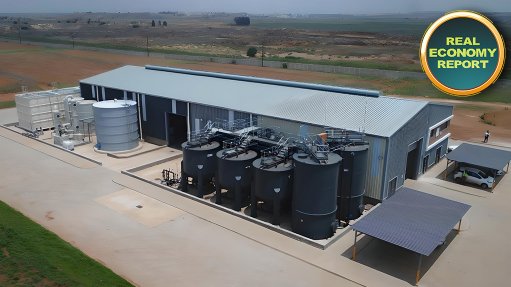How harvested wood products can create climate friendly solutions
This article has been supplied as a media statement and is not written by Creamer Media. It may be available only for a limited time on this website.
By Jane Molony, executive director, Paper Manufacturers Association of South Africa
Despite misinformation to the contrary, using wood from sustainably managed forests to make things like paper and packaging can help the environment. With Earth Day coming up on 22 April, the Paper Manufacturers Association of South Africa (PAMSA) argues that using harvested wood products could be the weapon in our fight against the climate crisis.
Our biggest allies in this fight are trees – of all kinds. The forest sector involves the farming of specific tree species for timber, pulp and paper applications, the collection and recycling of paper fibre, and the beneficiation of process waste., and much more.
According to Forestry South Africa, South Africa only has half a million hectares of closed canopy indigenous forests (0.4% of land cover) and 1.2 million hectares of planted forests with the latter needed to produce wood and fibre on a sustainable basis and relieve pressure on natural forests.
However, knowledge gaps and a misunderstanding of the role of forests and forest products still exist. While many people recognise that wood and paper are sustainable materials and that we should be doing more to use them, they also argue that all types of trees – regardless of their type and purpose – should be kept in the ground. This widely held belief perpetuates the myth that deforestation is caused by wood and paper production.
Balancing production and protection
Firstly, indigenous trees, which have slow growth rates, are never used for pulp, paper and packaging.
Secondly, South Africa has 850 million trees growing on more than 676 000 hectares reserved for pulp and papermaking. Less than 10% of this total area is harvested during any year, and the same area is replanted with new trees – specially cultivated saplings.
To achieve a sustained yield and prevent the depletion of growing stock (trees in the ground), the annual harvest should never exceed the annual planting. South Africa has been employing this concept since 1880 and has since advanced to sustainable forest management (SFM).
SFM seeks to maintain a stable forestry landscape by managing the environmental quality and the resource base on which it depends - such as land, water and biodiversity, supplying products and services for human needs, being economically viable and improving the quality of life of communities.
One example is that some harvesting residues can be left in-situ as mulch. Bark, limbs, and leaves offer sustenance and refuge for creatures that aid in the decomposition of organic matter, which in turn attracts birds and other foragers.
Looking to age-old natural processes for our planet’s future
All plants take up carbon dioxide from our atmosphere. They keep the carbon for growth and give us back the oxygen. It’s a beautiful thing! The trees we use for harvested wood products keep that carbon locked up.
And it’s not just wood and paper that have this potential.
Wood – when broken down into its central components of cellulose, hemi-cellulose and lignin – can be used to produce a range of substances that go into the manufacture of common household products and innovative substitutes for fossil-fuel based products.
For example, viscose is a material made from wood and used to make soft and absorbent products like disinfecting wipes, towels, linen, and clothing. Hydroxyethyl cellulose (HEC) is used in paint walls to prevent splatter and is also used in cosmetics, adhesives, and detergents. Cellulose triacetate is used to make laptop screens that provide clear images.
By using more sustainable farmed wood-based products, and planting more trees to replace the harvested stock, we not only keep the carbon cycle in balance, but we also increase the sector’s potential to take up more carbon, store more carbon and finding low carbon solutions for everyday needs.
All of this goes to show, that through sustainable practices and the building of circular bioeconomy’s, we can turn the tide against climate change.
Comments
Press Office
Announcements
What's On
Subscribe to improve your user experience...
Option 1 (equivalent of R125 a month):
Receive a weekly copy of Creamer Media's Engineering News & Mining Weekly magazine
(print copy for those in South Africa and e-magazine for those outside of South Africa)
Receive daily email newsletters
Access to full search results
Access archive of magazine back copies
Access to Projects in Progress
Access to ONE Research Report of your choice in PDF format
Option 2 (equivalent of R375 a month):
All benefits from Option 1
PLUS
Access to Creamer Media's Research Channel Africa for ALL Research Reports, in PDF format, on various industrial and mining sectors
including Electricity; Water; Energy Transition; Hydrogen; Roads, Rail and Ports; Coal; Gold; Platinum; Battery Metals; etc.
Already a subscriber?
Forgotten your password?
Receive weekly copy of Creamer Media's Engineering News & Mining Weekly magazine (print copy for those in South Africa and e-magazine for those outside of South Africa)
➕
Recieve daily email newsletters
➕
Access to full search results
➕
Access archive of magazine back copies
➕
Access to Projects in Progress
➕
Access to ONE Research Report of your choice in PDF format
RESEARCH CHANNEL AFRICA
R4500 (equivalent of R375 a month)
SUBSCRIBEAll benefits from Option 1
➕
Access to Creamer Media's Research Channel Africa for ALL Research Reports on various industrial and mining sectors, in PDF format, including on:
Electricity
➕
Water
➕
Energy Transition
➕
Hydrogen
➕
Roads, Rail and Ports
➕
Coal
➕
Gold
➕
Platinum
➕
Battery Metals
➕
etc.
Receive all benefits from Option 1 or Option 2 delivered to numerous people at your company
➕
Multiple User names and Passwords for simultaneous log-ins
➕
Intranet integration access to all in your organisation



















